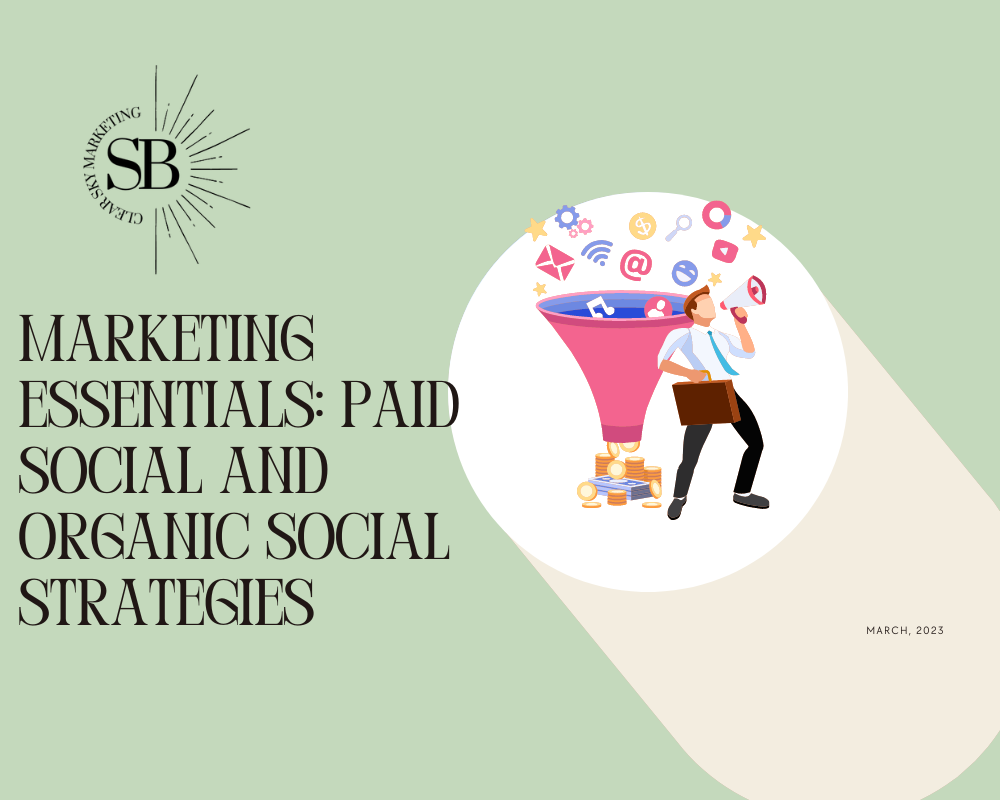Paid Social
Paid social media or more commonly referred to as “advertising” is a marketing strategy in which third-party platforms are paid to share or boost content to reach desired target markets. These third-party platforms include but or not limited to, Facebook, YouTube, Instagram, Twitter, etc. all of which serve as different distribution channels that have varying benefits for reaching new target audiences.

While organic social at face level may seem to be the better option because it’s “free,” with the implementation of ranking algorithms on most media platforms marketers must invest in paid social. Ranking algorithms have changed the way marketers approach digital marketing, and relying solely on organic social media is insufficient for those who are competing against companies with a much larger consumer audience.
Organic Social
Organic social media is the content shared between users, businesses, and brands without a monetary incentive. Organic social media is extremely important for brands to create and maintain a relationship with their consumers. Social media has given companies an outlet in which they can directly connect with consumers and create a brand personality. Consumers prefer authentic and honest brands that engage with them, which are achievable goals through an effective organic social media strategy. Of course, to be effective in these marketing efforts, it is extremely important to know your customer to provide them with relevant content that will give them awareness and lead them through the marketing funnel. Organic social media also creates validity for brands. For example, an online review is an example of effective organic social media as 88% of people trust online reviews made by other people. Once people have piqued interest in a brand through paid social, organic social media is imperative to form a meaningful and trusting relationship with consumers and increase customer retention.

Paid Social media vs Organic Social Media
Both organic and paid social media strategies are implemented to gain new customers and followers. Due to the competitive nature of ranking algorithms, the reach of organic social media posts is compromised making it extremely important to invest in paid social media. To put this into perspective, an organic Facebook post on average reaches 5.5% of a brand’s followers. Therefore to expand one’s consumer base implementing a paid social media strategy is a necessary step. Paid social media reaches desired audiences faster than organic. Another beneficial component of paid social media is that it is much easier to measure and evaluate the effectiveness of a paid social media campaign. By analyzing the impressions and engagement of a paid social campaign, marketers can use this information to implement real-time changes to improve the effectiveness of the campaign. Marketers can also look at the click-through rate of an advertisement to determine how many advertisement viewers clicked on the link associated with the ad. Although paid and organic social media helps marketers achieve different objectives, they are both fundamental to promoting quality content for consumers.

Paid Social Tools
A crucial step of an effective paid social media campaign is to understand your ideal audience, and Facebook has developed a framework available to marketers to reach desired audiences. This is an exciting framework available to marketers as Facebook remains to be the most used social media platform to date with 2.958 billion users.
Facebook has defined three different ad targeting options based on audience type:
- Core Audience: define an audience based on criteria like age, interests, geography, and more. Your core audience makes up your target market, the group of people who will find value in what is being advertised.
- Custom Audience: Ad targeting positions that let you find your existing audiences among people across Meta technologies. Meta owns Facebook, Instagram, and WhatsApp, therefore through the custom audience tool, advertisers are granted the ability to see who among the users of those applications aligns with the target market.
- Lookalike Audience: Lists of people to target with advertising who are similar to the people currently engaging with your business. Lookalike audiences are a useful tool when hoping to gain new consumers, and lead to more cost-efficient efforts as marketers will have more confidence in the effectiveness of their paid social campaigns.
Influencer Marketing
Influencer marketing consists of collaborations between influencers and brands, in which brands pay influencers to promote their products and/or services through social media networks. Influencer marketing can be a useful tool for a company hoping to increase brand awareness, generate sales, or boost sales. When investing in influencer marketing, picking the “right” influencer is important in building an effective influencer marketing campaign. When a brand collaborates with an influencer, consumers will then associate your brand with that consumer. The influencer must represent the values of the brand as influencer marketing campaigns work to build brand credibility and consumer relationships.

Once an influencer marketing campaign is released you must determine if the campaign was successful. This is dependent upon the campaign-specific KPIs (key performance indicators). These KPIs can be tracked using Google Analytics, which will give insight into how effective the campaign is in terms of reaching the defined business objectives. Another way in which you can measure success when working with influencers is by using affiliate links and promotional codes. Affiliate links will give insight into which purchases and traffic the website is unique to the influencer campaign. Similarly, with promotional codes, marketers can track the number of people who used the campaign-specific code at checkout. It is also beneficial to track impressions and engagement before, during, and after the release of the campaign. Influencers will also have useful personal data and analytics, therefore you should always ask the influencer if they are comfortable sharing this information to guide future influencer marketing campaigns.
Marketers must invest in effective paid social media and organic social media to gain new consumers and form valuable connections with consumers. Paid social is an effective tool to reach a larger audience, while organic social allows brands to build relationships with consumers to create a loyal customer base.

